MBA Project: Optimization of Consumer Goods Supply Routes
VerifiedAdded on 2022/09/02
|7
|1570
|18
Project
AI Summary
This project proposal focuses on optimizing the process of forming supply routes for consumer goods within distribution centers. The rationale highlights the need for continuous improvement in logistics due to market dynamics, transport network development, and changing regulations. The study aims to create a common algorithmic platform using evolutionary metaheuristics to solve transport logistics problems, potentially improving the efficiency of supply chains. The project will explore various models and methods from logistics, operations research, and information technology to reduce enterprise costs by optimizing route formation and rational distribution of goods. The methodology involves analyzing existing models, such as those using linear programming, and proposing a new approach based on a common platform of spanning trees. The findings from this research will be crucial for improving the quality of functioning in supply chains of consumer goods.
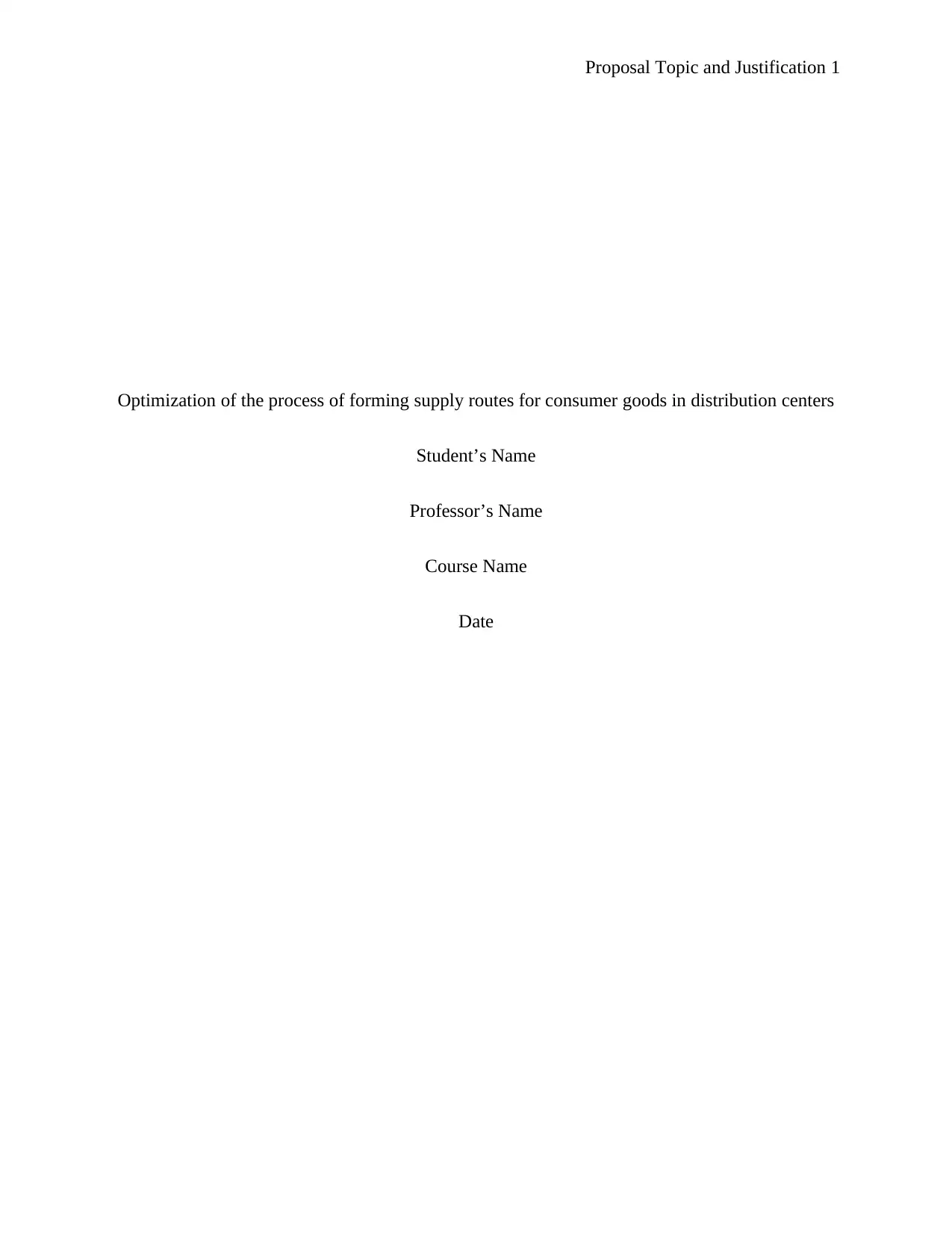
Proposal Topic and Justification 1
Optimization of the process of forming supply routes for consumer goods in distribution centers
Student’s Name
Professor’s Name
Course Name
Date
Optimization of the process of forming supply routes for consumer goods in distribution centers
Student’s Name
Professor’s Name
Course Name
Date
Paraphrase This Document
Need a fresh take? Get an instant paraphrase of this document with our AI Paraphraser
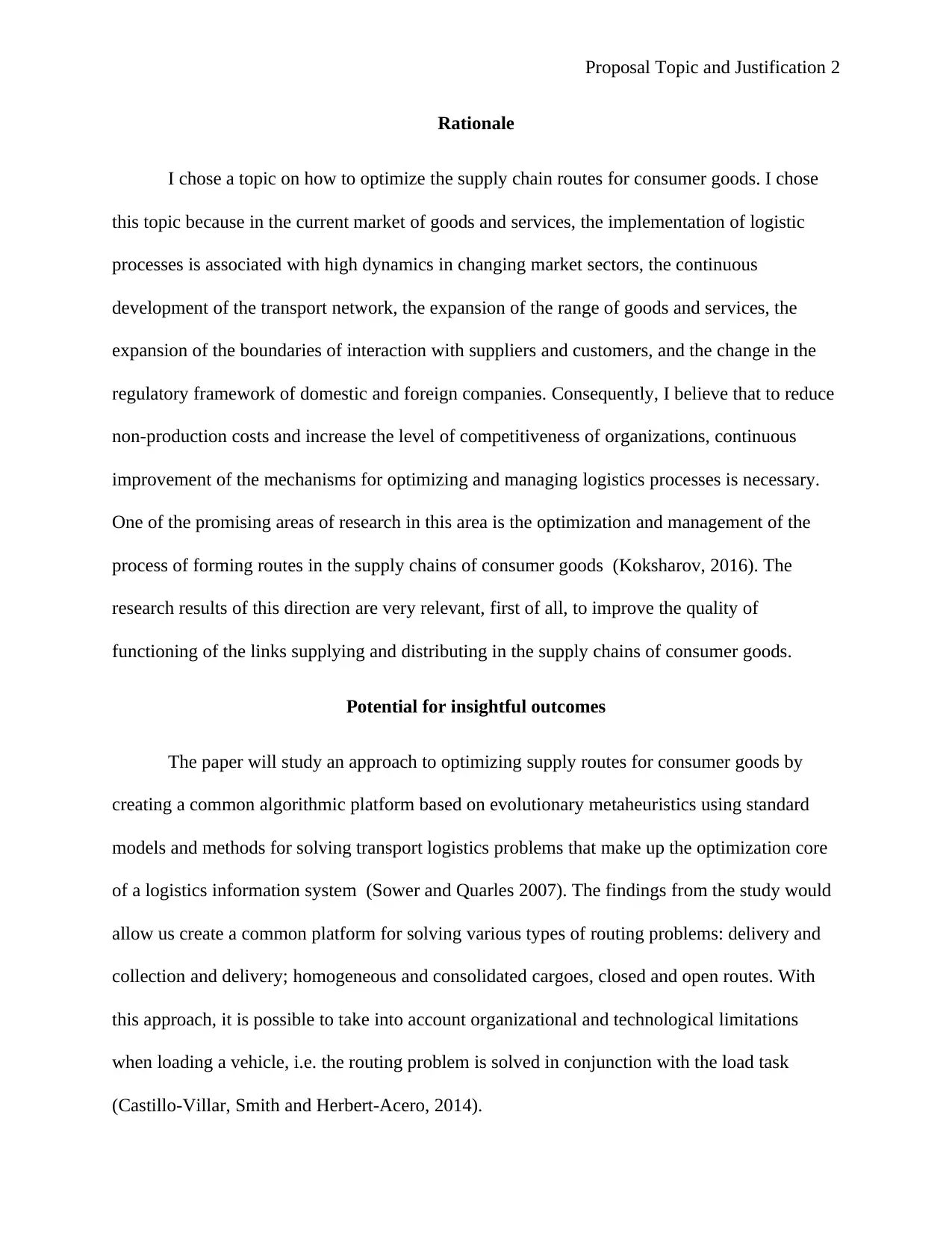
Proposal Topic and Justification 2
Rationale
I chose a topic on how to optimize the supply chain routes for consumer goods. I chose
this topic because in the current market of goods and services, the implementation of logistic
processes is associated with high dynamics in changing market sectors, the continuous
development of the transport network, the expansion of the range of goods and services, the
expansion of the boundaries of interaction with suppliers and customers, and the change in the
regulatory framework of domestic and foreign companies. Consequently, I believe that to reduce
non-production costs and increase the level of competitiveness of organizations, continuous
improvement of the mechanisms for optimizing and managing logistics processes is necessary.
One of the promising areas of research in this area is the optimization and management of the
process of forming routes in the supply chains of consumer goods (Koksharov, 2016). The
research results of this direction are very relevant, first of all, to improve the quality of
functioning of the links supplying and distributing in the supply chains of consumer goods.
Potential for insightful outcomes
The paper will study an approach to optimizing supply routes for consumer goods by
creating a common algorithmic platform based on evolutionary metaheuristics using standard
models and methods for solving transport logistics problems that make up the optimization core
of a logistics information system (Sower and Quarles 2007). The findings from the study would
allow us create a common platform for solving various types of routing problems: delivery and
collection and delivery; homogeneous and consolidated cargoes, closed and open routes. With
this approach, it is possible to take into account organizational and technological limitations
when loading a vehicle, i.e. the routing problem is solved in conjunction with the load task
(Castillo-Villar, Smith and Herbert-Acero, 2014).
Rationale
I chose a topic on how to optimize the supply chain routes for consumer goods. I chose
this topic because in the current market of goods and services, the implementation of logistic
processes is associated with high dynamics in changing market sectors, the continuous
development of the transport network, the expansion of the range of goods and services, the
expansion of the boundaries of interaction with suppliers and customers, and the change in the
regulatory framework of domestic and foreign companies. Consequently, I believe that to reduce
non-production costs and increase the level of competitiveness of organizations, continuous
improvement of the mechanisms for optimizing and managing logistics processes is necessary.
One of the promising areas of research in this area is the optimization and management of the
process of forming routes in the supply chains of consumer goods (Koksharov, 2016). The
research results of this direction are very relevant, first of all, to improve the quality of
functioning of the links supplying and distributing in the supply chains of consumer goods.
Potential for insightful outcomes
The paper will study an approach to optimizing supply routes for consumer goods by
creating a common algorithmic platform based on evolutionary metaheuristics using standard
models and methods for solving transport logistics problems that make up the optimization core
of a logistics information system (Sower and Quarles 2007). The findings from the study would
allow us create a common platform for solving various types of routing problems: delivery and
collection and delivery; homogeneous and consolidated cargoes, closed and open routes. With
this approach, it is possible to take into account organizational and technological limitations
when loading a vehicle, i.e. the routing problem is solved in conjunction with the load task
(Castillo-Villar, Smith and Herbert-Acero, 2014).
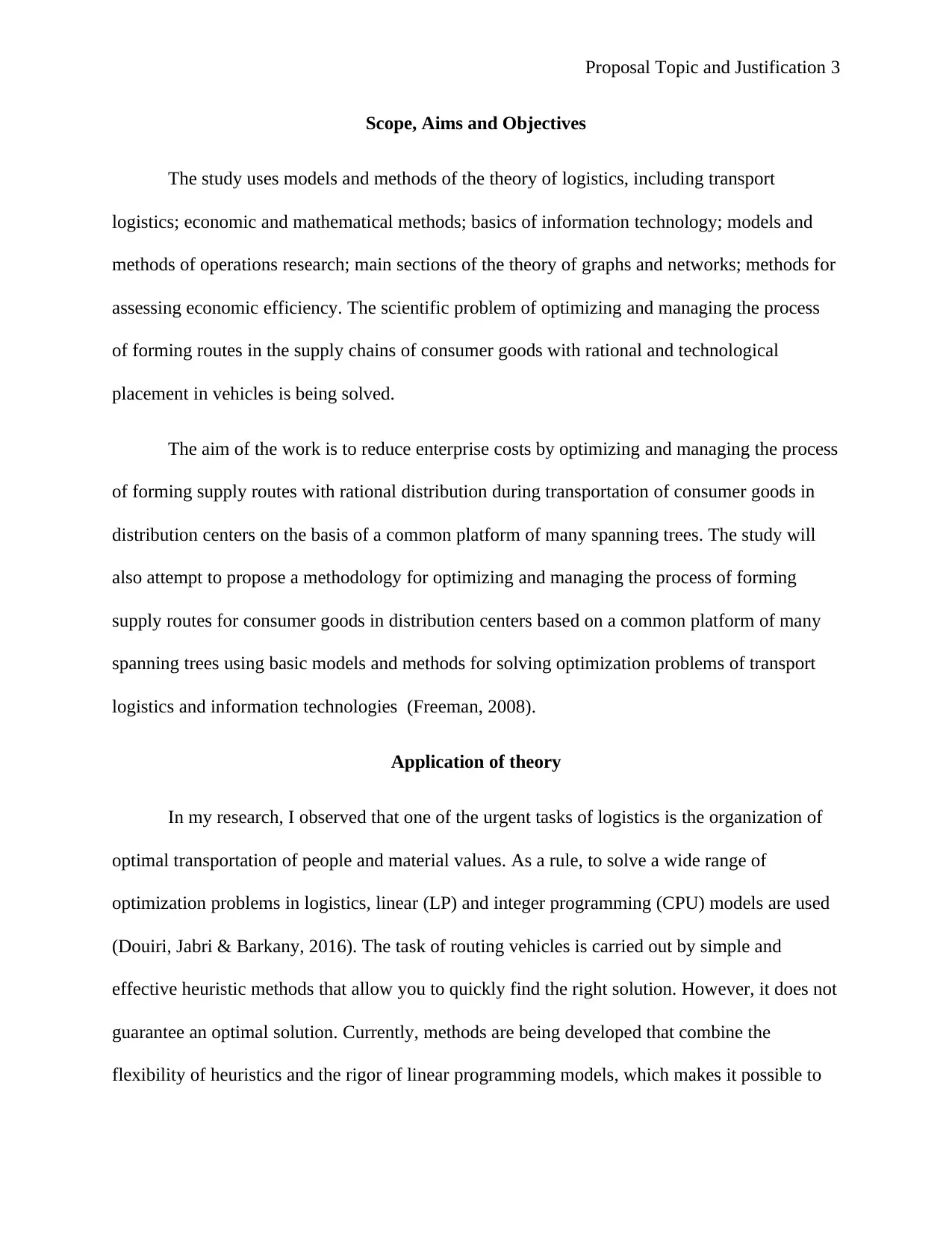
Proposal Topic and Justification 3
Scope, Aims and Objectives
The study uses models and methods of the theory of logistics, including transport
logistics; economic and mathematical methods; basics of information technology; models and
methods of operations research; main sections of the theory of graphs and networks; methods for
assessing economic efficiency. The scientific problem of optimizing and managing the process
of forming routes in the supply chains of consumer goods with rational and technological
placement in vehicles is being solved.
The aim of the work is to reduce enterprise costs by optimizing and managing the process
of forming supply routes with rational distribution during transportation of consumer goods in
distribution centers on the basis of a common platform of many spanning trees. The study will
also attempt to propose a methodology for optimizing and managing the process of forming
supply routes for consumer goods in distribution centers based on a common platform of many
spanning trees using basic models and methods for solving optimization problems of transport
logistics and information technologies (Freeman, 2008).
Application of theory
In my research, I observed that one of the urgent tasks of logistics is the organization of
optimal transportation of people and material values. As a rule, to solve a wide range of
optimization problems in logistics, linear (LP) and integer programming (CPU) models are used
(Douiri, Jabri & Barkany, 2016). The task of routing vehicles is carried out by simple and
effective heuristic methods that allow you to quickly find the right solution. However, it does not
guarantee an optimal solution. Currently, methods are being developed that combine the
flexibility of heuristics and the rigor of linear programming models, which makes it possible to
Scope, Aims and Objectives
The study uses models and methods of the theory of logistics, including transport
logistics; economic and mathematical methods; basics of information technology; models and
methods of operations research; main sections of the theory of graphs and networks; methods for
assessing economic efficiency. The scientific problem of optimizing and managing the process
of forming routes in the supply chains of consumer goods with rational and technological
placement in vehicles is being solved.
The aim of the work is to reduce enterprise costs by optimizing and managing the process
of forming supply routes with rational distribution during transportation of consumer goods in
distribution centers on the basis of a common platform of many spanning trees. The study will
also attempt to propose a methodology for optimizing and managing the process of forming
supply routes for consumer goods in distribution centers based on a common platform of many
spanning trees using basic models and methods for solving optimization problems of transport
logistics and information technologies (Freeman, 2008).
Application of theory
In my research, I observed that one of the urgent tasks of logistics is the organization of
optimal transportation of people and material values. As a rule, to solve a wide range of
optimization problems in logistics, linear (LP) and integer programming (CPU) models are used
(Douiri, Jabri & Barkany, 2016). The task of routing vehicles is carried out by simple and
effective heuristic methods that allow you to quickly find the right solution. However, it does not
guarantee an optimal solution. Currently, methods are being developed that combine the
flexibility of heuristics and the rigor of linear programming models, which makes it possible to
⊘ This is a preview!⊘
Do you want full access?
Subscribe today to unlock all pages.

Trusted by 1+ million students worldwide
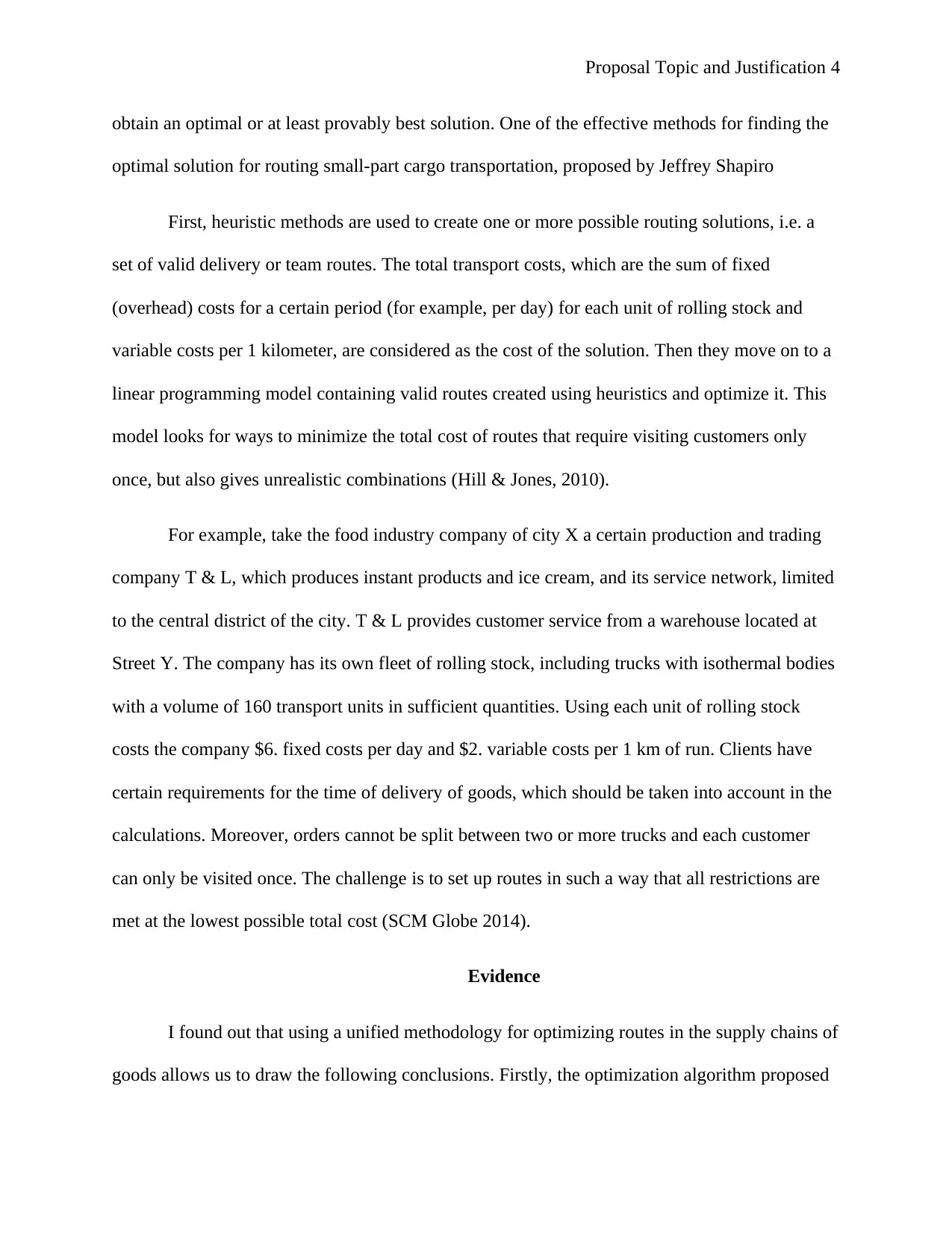
Proposal Topic and Justification 4
obtain an optimal or at least provably best solution. One of the effective methods for finding the
optimal solution for routing small-part cargo transportation, proposed by Jeffrey Shapiro
First, heuristic methods are used to create one or more possible routing solutions, i.e. a
set of valid delivery or team routes. The total transport costs, which are the sum of fixed
(overhead) costs for a certain period (for example, per day) for each unit of rolling stock and
variable costs per 1 kilometer, are considered as the cost of the solution. Then they move on to a
linear programming model containing valid routes created using heuristics and optimize it. This
model looks for ways to minimize the total cost of routes that require visiting customers only
once, but also gives unrealistic combinations (Hill & Jones, 2010).
For example, take the food industry company of city X a certain production and trading
company T & L, which produces instant products and ice cream, and its service network, limited
to the central district of the city. T & L provides customer service from a warehouse located at
Street Y. The company has its own fleet of rolling stock, including trucks with isothermal bodies
with a volume of 160 transport units in sufficient quantities. Using each unit of rolling stock
costs the company $6. fixed costs per day and $2. variable costs per 1 km of run. Clients have
certain requirements for the time of delivery of goods, which should be taken into account in the
calculations. Moreover, orders cannot be split between two or more trucks and each customer
can only be visited once. The challenge is to set up routes in such a way that all restrictions are
met at the lowest possible total cost (SCM Globe 2014).
Evidence
I found out that using a unified methodology for optimizing routes in the supply chains of
goods allows us to draw the following conclusions. Firstly, the optimization algorithm proposed
obtain an optimal or at least provably best solution. One of the effective methods for finding the
optimal solution for routing small-part cargo transportation, proposed by Jeffrey Shapiro
First, heuristic methods are used to create one or more possible routing solutions, i.e. a
set of valid delivery or team routes. The total transport costs, which are the sum of fixed
(overhead) costs for a certain period (for example, per day) for each unit of rolling stock and
variable costs per 1 kilometer, are considered as the cost of the solution. Then they move on to a
linear programming model containing valid routes created using heuristics and optimize it. This
model looks for ways to minimize the total cost of routes that require visiting customers only
once, but also gives unrealistic combinations (Hill & Jones, 2010).
For example, take the food industry company of city X a certain production and trading
company T & L, which produces instant products and ice cream, and its service network, limited
to the central district of the city. T & L provides customer service from a warehouse located at
Street Y. The company has its own fleet of rolling stock, including trucks with isothermal bodies
with a volume of 160 transport units in sufficient quantities. Using each unit of rolling stock
costs the company $6. fixed costs per day and $2. variable costs per 1 km of run. Clients have
certain requirements for the time of delivery of goods, which should be taken into account in the
calculations. Moreover, orders cannot be split between two or more trucks and each customer
can only be visited once. The challenge is to set up routes in such a way that all restrictions are
met at the lowest possible total cost (SCM Globe 2014).
Evidence
I found out that using a unified methodology for optimizing routes in the supply chains of
goods allows us to draw the following conclusions. Firstly, the optimization algorithm proposed
Paraphrase This Document
Need a fresh take? Get an instant paraphrase of this document with our AI Paraphraser
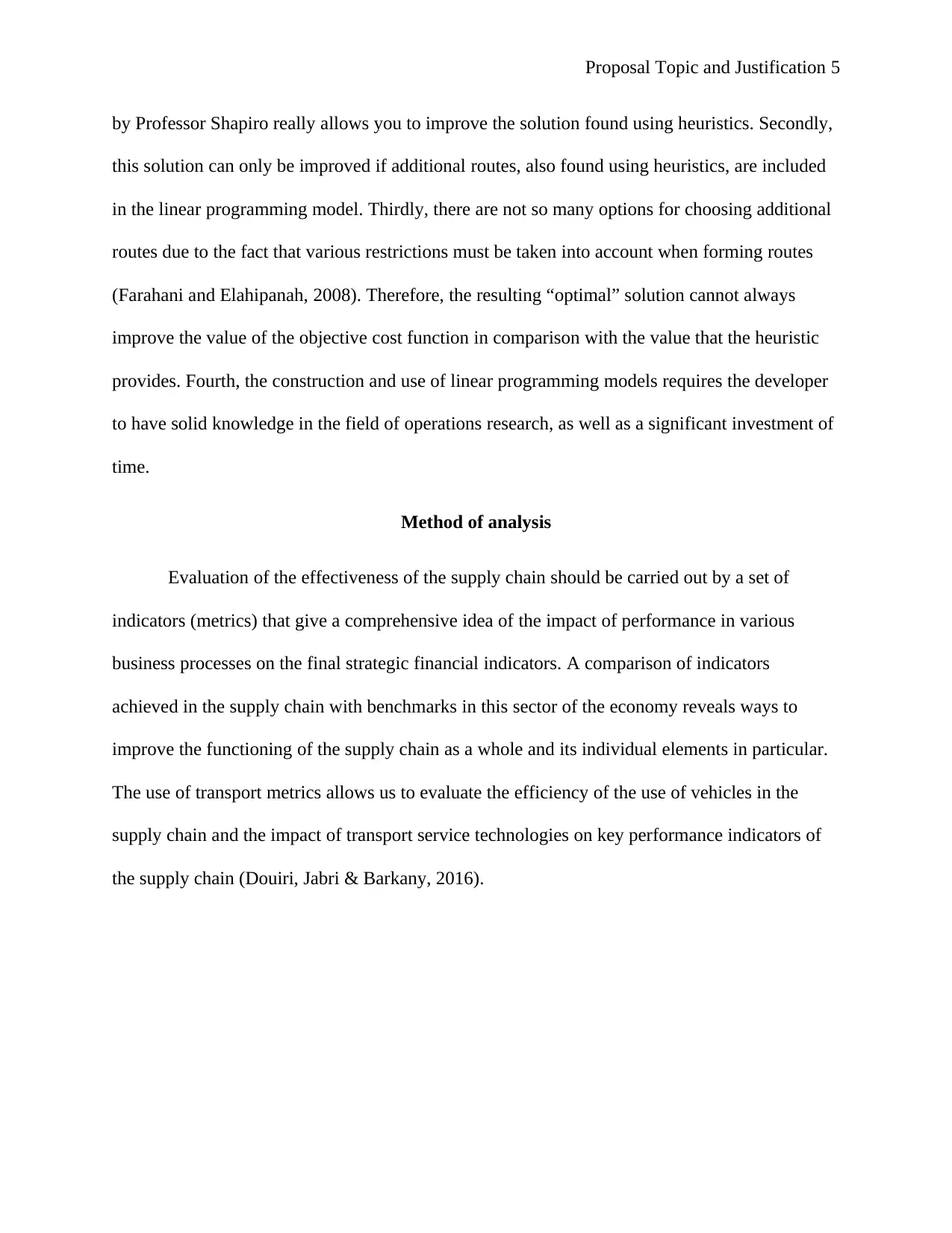
Proposal Topic and Justification 5
by Professor Shapiro really allows you to improve the solution found using heuristics. Secondly,
this solution can only be improved if additional routes, also found using heuristics, are included
in the linear programming model. Thirdly, there are not so many options for choosing additional
routes due to the fact that various restrictions must be taken into account when forming routes
(Farahani and Elahipanah, 2008). Therefore, the resulting “optimal” solution cannot always
improve the value of the objective cost function in comparison with the value that the heuristic
provides. Fourth, the construction and use of linear programming models requires the developer
to have solid knowledge in the field of operations research, as well as a significant investment of
time.
Method of analysis
Evaluation of the effectiveness of the supply chain should be carried out by a set of
indicators (metrics) that give a comprehensive idea of the impact of performance in various
business processes on the final strategic financial indicators. A comparison of indicators
achieved in the supply chain with benchmarks in this sector of the economy reveals ways to
improve the functioning of the supply chain as a whole and its individual elements in particular.
The use of transport metrics allows us to evaluate the efficiency of the use of vehicles in the
supply chain and the impact of transport service technologies on key performance indicators of
the supply chain (Douiri, Jabri & Barkany, 2016).
by Professor Shapiro really allows you to improve the solution found using heuristics. Secondly,
this solution can only be improved if additional routes, also found using heuristics, are included
in the linear programming model. Thirdly, there are not so many options for choosing additional
routes due to the fact that various restrictions must be taken into account when forming routes
(Farahani and Elahipanah, 2008). Therefore, the resulting “optimal” solution cannot always
improve the value of the objective cost function in comparison with the value that the heuristic
provides. Fourth, the construction and use of linear programming models requires the developer
to have solid knowledge in the field of operations research, as well as a significant investment of
time.
Method of analysis
Evaluation of the effectiveness of the supply chain should be carried out by a set of
indicators (metrics) that give a comprehensive idea of the impact of performance in various
business processes on the final strategic financial indicators. A comparison of indicators
achieved in the supply chain with benchmarks in this sector of the economy reveals ways to
improve the functioning of the supply chain as a whole and its individual elements in particular.
The use of transport metrics allows us to evaluate the efficiency of the use of vehicles in the
supply chain and the impact of transport service technologies on key performance indicators of
the supply chain (Douiri, Jabri & Barkany, 2016).
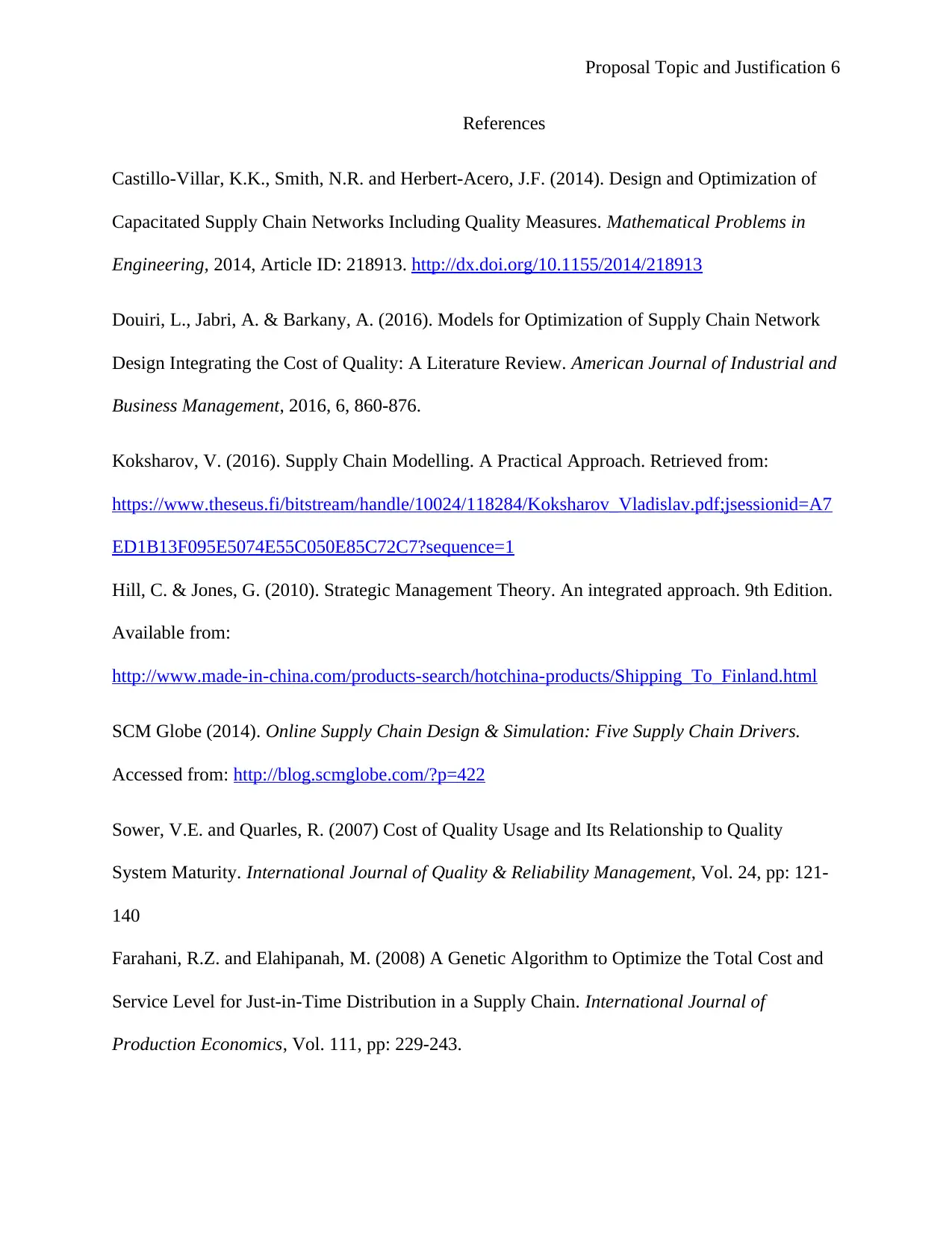
Proposal Topic and Justification 6
References
Castillo-Villar, K.K., Smith, N.R. and Herbert-Acero, J.F. (2014). Design and Optimization of
Capacitated Supply Chain Networks Including Quality Measures. Mathematical Problems in
Engineering, 2014, Article ID: 218913. http://dx.doi.org/10.1155/2014/218913
Douiri, L., Jabri, A. & Barkany, A. (2016). Models for Optimization of Supply Chain Network
Design Integrating the Cost of Quality: A Literature Review. American Journal of Industrial and
Business Management, 2016, 6, 860-876.
Koksharov, V. (2016). Supply Chain Modelling. A Practical Approach. Retrieved from:
https://www.theseus.fi/bitstream/handle/10024/118284/Koksharov_Vladislav.pdf;jsessionid=A7
ED1B13F095E5074E55C050E85C72C7?sequence=1
Hill, C. & Jones, G. (2010). Strategic Management Theory. An integrated approach. 9th Edition.
Available from:
http://www.made-in-china.com/products-search/hotchina-products/Shipping_To_Finland.html
SCM Globe (2014). Online Supply Chain Design & Simulation: Five Supply Chain Drivers.
Accessed from: http://blog.scmglobe.com/?p=422
Sower, V.E. and Quarles, R. (2007) Cost of Quality Usage and Its Relationship to Quality
System Maturity. International Journal of Quality & Reliability Management, Vol. 24, pp: 121-
140
Farahani, R.Z. and Elahipanah, M. (2008) A Genetic Algorithm to Optimize the Total Cost and
Service Level for Just-in-Time Distribution in a Supply Chain. International Journal of
Production Economics, Vol. 111, pp: 229-243.
References
Castillo-Villar, K.K., Smith, N.R. and Herbert-Acero, J.F. (2014). Design and Optimization of
Capacitated Supply Chain Networks Including Quality Measures. Mathematical Problems in
Engineering, 2014, Article ID: 218913. http://dx.doi.org/10.1155/2014/218913
Douiri, L., Jabri, A. & Barkany, A. (2016). Models for Optimization of Supply Chain Network
Design Integrating the Cost of Quality: A Literature Review. American Journal of Industrial and
Business Management, 2016, 6, 860-876.
Koksharov, V. (2016). Supply Chain Modelling. A Practical Approach. Retrieved from:
https://www.theseus.fi/bitstream/handle/10024/118284/Koksharov_Vladislav.pdf;jsessionid=A7
ED1B13F095E5074E55C050E85C72C7?sequence=1
Hill, C. & Jones, G. (2010). Strategic Management Theory. An integrated approach. 9th Edition.
Available from:
http://www.made-in-china.com/products-search/hotchina-products/Shipping_To_Finland.html
SCM Globe (2014). Online Supply Chain Design & Simulation: Five Supply Chain Drivers.
Accessed from: http://blog.scmglobe.com/?p=422
Sower, V.E. and Quarles, R. (2007) Cost of Quality Usage and Its Relationship to Quality
System Maturity. International Journal of Quality & Reliability Management, Vol. 24, pp: 121-
140
Farahani, R.Z. and Elahipanah, M. (2008) A Genetic Algorithm to Optimize the Total Cost and
Service Level for Just-in-Time Distribution in a Supply Chain. International Journal of
Production Economics, Vol. 111, pp: 229-243.
⊘ This is a preview!⊘
Do you want full access?
Subscribe today to unlock all pages.

Trusted by 1+ million students worldwide
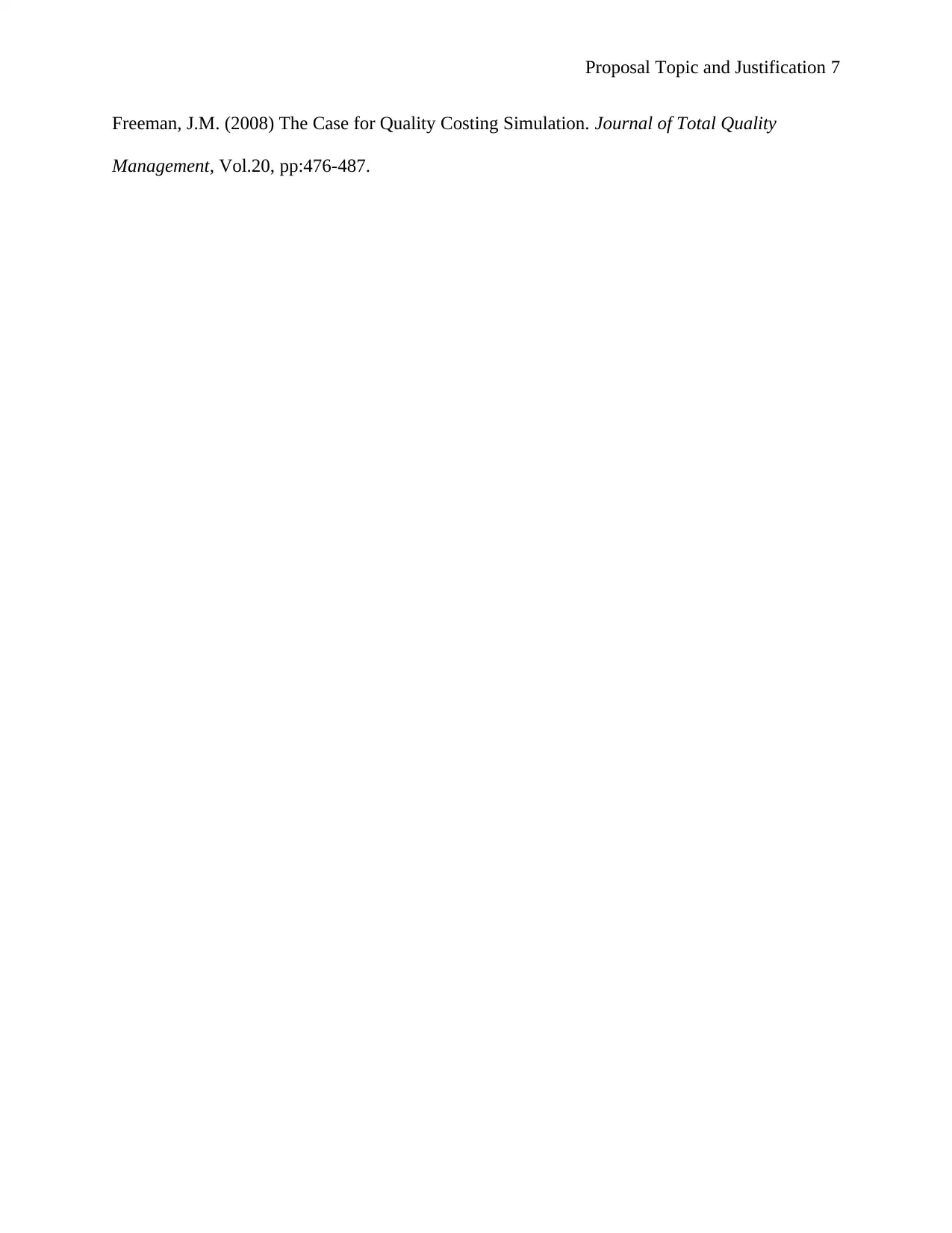
Proposal Topic and Justification 7
Freeman, J.M. (2008) The Case for Quality Costing Simulation. Journal of Total Quality
Management, Vol.20, pp:476-487.
Freeman, J.M. (2008) The Case for Quality Costing Simulation. Journal of Total Quality
Management, Vol.20, pp:476-487.
1 out of 7
Related Documents
Your All-in-One AI-Powered Toolkit for Academic Success.
+13062052269
info@desklib.com
Available 24*7 on WhatsApp / Email
![[object Object]](/_next/static/media/star-bottom.7253800d.svg)
Unlock your academic potential
Copyright © 2020–2025 A2Z Services. All Rights Reserved. Developed and managed by ZUCOL.





